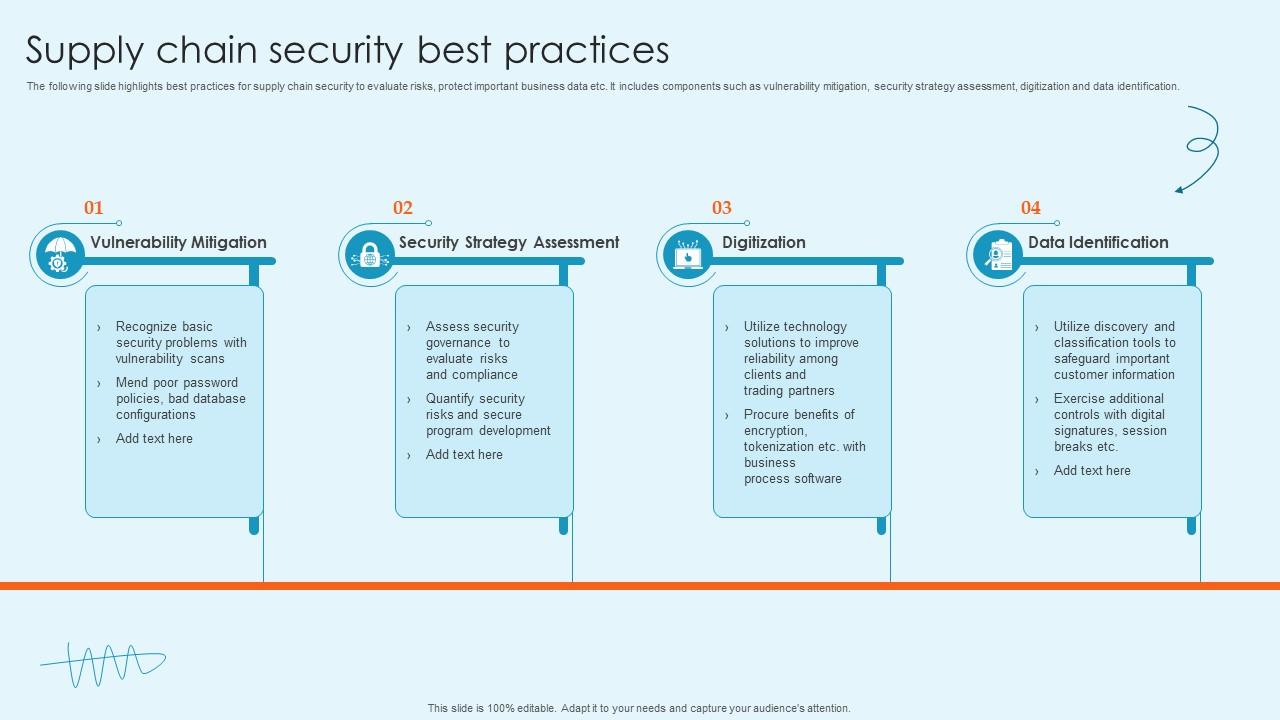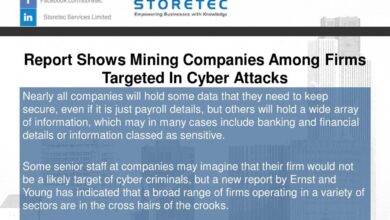
5 Steps to Stronger Vendor Security and Reduced Supply Chain Risk
5 Steps to Stronger Vendor Security and Reduced Supply Chain Risk: Ever felt that nagging worry about your supply chain’s vulnerability? It’s a valid concern in today’s interconnected world. This post breaks down five crucial steps to bolster your vendor security, minimizing risks and ensuring business continuity. We’ll cover everything from identifying high-risk vendors to implementing robust security controls and establishing secure communication protocols.
Get ready to strengthen your defenses and sleep a little easier knowing your supply chain is protected!
We’ll delve into practical strategies, offering actionable advice you can implement immediately. From creating a vendor risk assessment matrix to negotiating airtight contracts, this guide provides a comprehensive roadmap to a more secure and resilient supply chain. We’ll also explore the importance of continuous monitoring and improvement, ensuring your security posture remains strong against evolving threats.
Understanding Your Vendor Landscape

Knowing your vendors is the bedrock of a strong supply chain. Ignoring this crucial step leaves your organization vulnerable to a range of risks, from financial instability to data breaches. A comprehensive understanding of your vendor landscape, including risk assessment and ongoing monitoring, is essential for mitigating these threats.Understanding your vendor landscape involves a multi-step process of identification, classification, and ongoing evaluation.
This isn’t a one-time task; it’s an ongoing cycle of assessment and improvement that demands consistent attention and resource allocation. The effort, however, is well worth the investment in reduced risk and enhanced security.
Vendor Identification and Classification, 5 steps to stronger vendor security and reduced supply chain risk
The first step is identifying all your vendors. This might seem straightforward, but it often requires a thorough search across different departments and systems. Once identified, vendors need classifying based on several key factors: industry, location, and criticality. High-risk vendors are often those operating in heavily regulated industries (like healthcare or finance), located in politically unstable regions, or providing critical services that significantly impact your operations.
For example, a vendor providing essential software infrastructure is far more critical than one supplying office stationery. Categorizing vendors in this manner allows you to prioritize your risk mitigation efforts.
Creating a Vendor Risk Assessment Matrix
A vendor risk assessment matrix provides a structured approach to evaluating the risks associated with each vendor. This matrix typically considers multiple factors, including financial stability (indicated by credit ratings and financial statements), security practices (such as certifications like ISO 27001 and adherence to security frameworks), and regulatory compliance (demonstrated through audits and certifications). A simple scoring system can be used to assign a risk level to each vendor, with higher scores indicating greater risk.
| Vendor Name | Risk Level (Low, Medium, High) | Criticality (Low, Medium, High) | Mitigation Plan |
|---|---|---|---|
| Acme Software Solutions | High | High | Implement multi-factor authentication, conduct regular security audits, and require annual SOC 2 reports. |
| Beta Office Supplies | Low | Low | Standard contract with data security clauses. |
| Gamma Manufacturing | Medium | Medium | Conduct on-site security assessment, review security policies, and require employee background checks. |
| Delta Logistics | Low | High | Implement robust contract with clear security expectations and regular performance reviews. |
Regularly Updating Vendor Information and Reassessing Risk Profiles
The vendor landscape is dynamic. Financial situations change, new regulations are introduced, and vendors evolve their security practices. Therefore, regularly updating vendor information and reassessing risk profiles is crucial. This might involve annual reviews, triggered by significant events (such as a security incident or change in ownership), or based on a risk-based approach prioritizing higher-risk vendors more frequently.
This continuous monitoring ensures that your risk mitigation strategies remain effective and relevant. For example, if a vendor experiences a significant financial downturn, their risk level might increase, requiring a more stringent mitigation plan.
Implementing Robust Security Controls
So, you’ve mapped out your vendor landscape. Excellent! Now it’s time to get serious about bolstering the security posture of those third-party partners. Implementing robust security controls isn’t just a good idea; it’s a critical step in mitigating supply chain risks and protecting your organization’s sensitive data. This involves setting clear expectations and verifying that your vendors are meeting them.This section focuses on the practical steps you can take to ensure your vendors are implementing the necessary security controls to protect your data and systems.
We’ll cover essential security measures, evaluation tools, and the importance of regular audits.
Essential Security Controls for Vendors
Implementing a comprehensive set of security controls is crucial for safeguarding your organization from potential threats originating from your vendors. These controls should cover various aspects of security, from access management to incident response. A strong security posture should be a non-negotiable requirement for any vendor you work with.
- Access Control: Vendors should implement strong access control measures, including multi-factor authentication (MFA), role-based access control (RBAC), and least privilege access. This limits access to only the necessary data and systems, minimizing the potential impact of a breach.
- Data Encryption: Both data at rest and data in transit should be encrypted using industry-standard encryption algorithms. This protects sensitive data from unauthorized access, even if a breach occurs.
- Vulnerability Management: Regular vulnerability scanning and patching should be conducted to identify and address security weaknesses promptly. This proactive approach helps prevent exploitation of known vulnerabilities.
- Incident Response Plan: Vendors should have a well-defined incident response plan in place to handle security incidents effectively. This plan should include procedures for detection, containment, eradication, recovery, and post-incident activity.
- Security Awareness Training: Regular security awareness training for all employees is crucial. This training should cover topics such as phishing awareness, password security, and social engineering tactics.
- Data Loss Prevention (DLP): Implement DLP measures to monitor and prevent sensitive data from leaving the organization’s control. This can involve monitoring data transfers, implementing data masking, and using DLP tools.
Vendor Security Questionnaires and Checklists
Using standardized questionnaires and checklists is an efficient way to evaluate vendor security practices. These tools provide a structured approach to gathering information and identifying potential weaknesses. Consistency in your evaluation process ensures a fair and thorough assessment of all your vendors.Examples of resources include the OWASP Application Security Verification Standard (ASVS) and the NIST Cybersecurity Framework, which offer guidance and templates for developing security questionnaires tailored to your specific needs.
Strengthening vendor security is crucial, and I’ve been thinking a lot about those five key steps to better supply chain risk management lately. One area that’s really impacted my thinking is application development; streamlining processes is key, which is why I’ve been digging into domino app dev the low code and pro code future – the efficiency gains could significantly improve our vendor’s security posture.
Ultimately, efficient app development directly contributes to the success of those five steps, making for a much more secure and resilient supply chain.
Many commercially available platforms also offer pre-built questionnaires and scoring mechanisms to streamline the process. A well-designed questionnaire should cover all the essential security controls mentioned above.
Security Audits and Penetration Testing in Vendor Contracts
Regular security audits and penetration testing are essential for validating the effectiveness of a vendor’s security controls. Incorporating these into vendor contracts ensures ongoing monitoring and improvement of their security posture. This proactive approach helps identify vulnerabilities before they can be exploited.The frequency of audits and penetration tests should be defined in the contract, considering the criticality of the vendor and the sensitivity of the data they handle.
For example, a vendor managing sensitive customer data might require more frequent audits than a vendor providing less critical services. The contract should also clearly Artikel the responsibilities of both parties regarding the audit process, including access to systems and data, reporting requirements, and remediation timelines. Penetration testing should simulate real-world attacks to identify vulnerabilities and assess the vendor’s ability to respond to such incidents.
The findings of these audits and tests should be documented and used to inform continuous improvement efforts.
Establishing Secure Communication and Data Exchange
Secure communication and data exchange are critical for maintaining the integrity of your supply chain and protecting sensitive information. A robust strategy ensures that data shared with vendors remains confidential, available, and trustworthy, minimizing the risk of breaches and disruptions. This involves carefully selecting appropriate methods for data transfer, implementing strong security protocols, and establishing clear processes for monitoring data flow.The choice of data exchange method significantly impacts security.
Each method presents unique advantages and disadvantages regarding security, cost, and ease of implementation. Understanding these nuances is crucial for designing a secure and efficient system.
Secure Communication Protocols
Designing a secure communication protocol requires careful consideration of several factors. The protocol should incorporate strong encryption to protect data in transit and at rest. This often involves using Transport Layer Security (TLS) or Secure Sockets Layer (SSL) for encrypted connections. Furthermore, the protocol should specify secure channels for data exchange, such as Virtual Private Networks (VPNs) to create a secure tunnel over a public network.
Implementing multi-factor authentication (MFA) adds another layer of security, requiring vendors to provide multiple forms of identification before accessing sensitive information. Regular security audits and penetration testing of the communication infrastructure are essential to identify and address vulnerabilities proactively. For example, a financial institution might use a VPN and TLS encryption to protect the transfer of customer data with a payment processing vendor.
Data Exchange Method Comparison
Different data exchange methods offer varying levels of security and efficiency. Application Programming Interfaces (APIs) offer automated, secure data exchange, ideal for high-volume transactions. However, they require technical expertise to implement and maintain. File transfers, using protocols like SFTP (SSH File Transfer Protocol), offer a simpler alternative but require careful management of access controls and encryption. Email, while convenient, is inherently insecure for sensitive data due to its vulnerability to phishing and interception.
A well-designed strategy might incorporate APIs for high-volume, automated data exchanges, SFTP for less frequent transfers of sensitive files, and restrict the use of email to non-sensitive communications.
Data Flow Management and Monitoring
Establishing a robust process for managing and monitoring data flow is essential. This includes defining clear data access controls, specifying who can access what data, and establishing logging and auditing mechanisms to track data access and modifications. Real-time monitoring tools can alert you to suspicious activity, enabling prompt responses to potential security incidents. Regular reviews of access permissions and data usage patterns are crucial to identify and address any anomalies.
For example, setting up alerts for unusual data access patterns or large data transfers outside normal business hours can help detect and prevent data breaches. This proactive approach is far more effective than reactive measures taken after a breach has already occurred.
Contractual Agreements and Legal Compliance: 5 Steps To Stronger Vendor Security And Reduced Supply Chain Risk
Protecting your organization from supply chain vulnerabilities requires more than just technical safeguards; it demands a robust legal framework. Solid contractual agreements and adherence to relevant regulations are crucial for ensuring vendor accountability and mitigating potential risks. This section delves into the importance of legally binding contracts and compliance with data protection laws in securing your vendor relationships.This involves carefully crafting contracts that clearly define security responsibilities, establishing liability in case of breaches, and incorporating security requirements into your service level agreements (SLAs).
Furthermore, understanding and adhering to relevant legal frameworks like GDPR and CCPA is essential for protecting sensitive data and avoiding hefty penalties.
Sample Vendor Contract Clause Addressing Security Responsibilities and Liabilities
A well-drafted vendor contract should explicitly Artikel security responsibilities for both parties. This prevents ambiguity and ensures accountability. Here’s an example clause that can be adapted to suit specific needs:
“The Vendor shall implement and maintain reasonable and appropriate security measures to protect Customer Data from unauthorized access, use, disclosure, alteration, or destruction, consistent with industry best practices and applicable laws and regulations, including but not limited to [list specific standards like ISO 27001, SOC 2]. In the event of a data breach involving Customer Data, the Vendor shall immediately notify the Customer and cooperate fully in the investigation and remediation efforts. The Vendor shall be liable for any damages directly resulting from its failure to comply with its security obligations under this agreement, up to a maximum of [Dollar amount or percentage].”
This clause establishes clear expectations for the vendor’s security posture and defines the consequences of non-compliance. Remember to consult with legal counsel to tailor this clause to your specific circumstances and jurisdiction.
Key Legal and Regulatory Requirements Related to Vendor Security and Data Protection
Several laws and regulations mandate specific security measures for organizations handling personal data. Two prominent examples are the General Data Protection Regulation (GDPR) in Europe and the California Consumer Privacy Act (CCPA) in the United States.GDPR requires organizations to implement appropriate technical and organizational measures to ensure a level of security appropriate to the risk. This includes data minimization, purpose limitation, and data security by design and default.
CCPA grants California consumers certain rights regarding their personal information, including the right to access, delete, and opt-out of the sale of their data. Vendors processing personal data must comply with these regulations to avoid significant penalties. Other regional regulations, such as the Brazilian LGPD, also need to be considered depending on the vendor’s location and the data processed.
Incorporating Security Requirements into Service Level Agreements (SLAs)
Service Level Agreements (SLAs) typically focus on performance metrics like uptime and response times. However, security should also be a key component. Including specific security requirements within your SLAs ensures vendors prioritize security alongside performance.For example, an SLA might include clauses specifying the vendor’s response time to security incidents, the frequency of security audits, and the required security certifications.
These metrics provide measurable targets for the vendor and a mechanism for holding them accountable for their security performance. A sample clause could be: “The Vendor shall provide a minimum of 99.9% uptime for the services provided and respond to security incidents within [number] hours. The Vendor will undergo an annual SOC 2 Type II audit.” This creates a direct link between service delivery and security performance.
Continuous Monitoring and Improvement

Maintaining strong vendor security isn’t a one-time fix; it’s an ongoing process. Regular monitoring and proactive improvements are crucial to mitigating evolving threats and ensuring the resilience of your supply chain. A robust continuous monitoring strategy will help identify weaknesses before they’re exploited, allowing for timely remediation and preventing costly breaches.Regular monitoring allows you to identify potential vulnerabilities in your vendor ecosystem and proactively address them before they lead to a security incident.
This proactive approach is significantly more cost-effective and less disruptive than reacting to a breach. By constantly assessing and updating your security program, you can ensure it remains effective against the ever-changing threat landscape.
Vendor Security Performance Monitoring
A comprehensive strategy for monitoring vendor security performance involves several key components. Firstly, establish clear Key Performance Indicators (KPIs) to measure vendor adherence to security standards. These KPIs might include the number of security incidents reported, the time taken to remediate vulnerabilities, and the effectiveness of security controls. Regularly scheduled security assessments, penetration testing, and vulnerability scans are also vital.
These assessments should be tailored to the specific risks associated with each vendor and their services. Finally, establishing a robust reporting mechanism allows for transparent communication of findings and progress. This ensures that any identified issues are addressed promptly and effectively.
Proactive Incident Response
Having a pre-defined incident response plan is crucial for dealing with security breaches involving vendors. This plan should detail clear roles and responsibilities, communication protocols, and escalation procedures. Regular drills and simulations will ensure your team is well-prepared to handle a real-world event. A key aspect of this plan is the ability to quickly isolate affected systems and contain the breach to prevent further damage.
This might involve temporarily suspending access to affected systems or services. Furthermore, a robust communication strategy is essential to keep stakeholders informed and maintain transparency during a crisis. This includes notifying affected parties and regulatory bodies as appropriate. Post-incident analysis is equally important to identify the root cause of the breach, learn from mistakes, and implement preventative measures to avoid future occurrences.
For example, a recent incident involving a third-party payment processor highlighted the importance of robust encryption and multi-factor authentication. The swift response, including immediate system shutdown and notification of customers, mitigated potential financial losses.
Regular Program Review and Updates
Regularly reviewing and updating your vendor security program is essential to adapt to evolving threats and best practices. This review should include an assessment of your current controls, emerging threats, and changes in regulatory requirements. Consider incorporating industry benchmarks and best practices into your program. Regular updates might involve changes to security policies, implementation of new technologies, or adjustments to your vendor risk management process.
The frequency of these reviews should depend on your risk tolerance and the dynamic nature of your vendor landscape. For example, a company dealing with highly sensitive data might require more frequent reviews than a company with less sensitive information.
Vendor Security Program Review Schedule
| Date | Action Taken | Result | Next Steps |
|---|---|---|---|
| Q1 2024 | Completed annual vendor security risk assessment; updated vendor security questionnaires. | Identified three high-risk vulnerabilities in vendor A’s systems. | Implement remediation plan with vendor A; schedule follow-up assessment in Q3 2024. |
| Q2 2024 | Implemented multi-factor authentication for all vendor access points. | Reduced successful login attempts from unauthorized sources by 80%. | Review and update MFA policies annually; conduct security awareness training for vendors. |
| Q3 2024 | Conducted penetration testing of vendor A’s systems; reviewed remediation efforts. | Confirmed successful remediation of high-risk vulnerabilities. | Schedule routine penetration testing for vendor A every six months. |
| Q4 2024 | Reviewed and updated vendor security policies to reflect new industry best practices and regulatory requirements. | Improved alignment with NIST Cybersecurity Framework. | Annual review and update of vendor security policies. |
Last Recap

Securing your vendor ecosystem is an ongoing journey, not a destination. By diligently following these five steps – understanding your vendor landscape, implementing robust security controls, establishing secure communication, crafting strong contracts, and continuously monitoring – you significantly reduce your supply chain risk. Remember, proactive security is the best defense against costly breaches and reputational damage. Start implementing these steps today and build a more resilient and secure future for your business!
FAQ Resource
What if a vendor refuses to comply with my security requirements?
This is a critical situation. You need to carefully assess the risk. If the vendor’s non-compliance poses a significant threat, you may need to reconsider your relationship with them, potentially seeking alternative vendors. Clearly defined contracts with consequences for non-compliance are crucial.
How often should I reassess my vendor risks?
Regular reassessment is vital. Aim for at least an annual review, but more frequent checks (e.g., semi-annually) might be necessary for high-risk vendors or in rapidly changing threat landscapes. Consider triggering reassessments after significant events like security incidents or regulatory changes.
What are some common vulnerabilities in vendor relationships?
Common vulnerabilities include weak access controls, inadequate data encryption, lack of incident response plans, insufficient security awareness training within the vendor’s organization, and failure to comply with relevant regulations (like GDPR or CCPA).
How can I incorporate security requirements into existing vendor contracts?
Amend existing contracts with addendums that clearly Artikel security expectations. You can also develop new contracts with dedicated security clauses covering areas like data protection, incident response, and audit rights. Legal counsel is highly recommended for this process.





